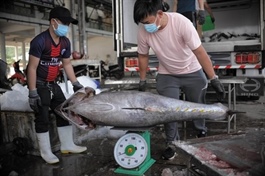Vietnam’s consumer gold demand down in 2023
Vietnam’s consumer gold demand down in 2023
Vietnam saw a slight drop in consumer gold demand, down 6 per cent on-year, from 59.1 tonnes in 2022 to 55.5 tonnes in 2023, according to the World Gold Council’s Gold Demand Trends report.

It said that gold bars and coins saw a modest on-year decline in 2023, settling at 40 tonnes, reflecting a marginal decrease of 2 per cent. Notably, investment in Vietnam gained traction in the fourth quarter, spurred by a price correction.
However, Vietnam experienced a substantial downturn in jewellery demand, declining by 16 per cent to 15 tons. This decline was marked by four consecutive quarterly on-year decreases, attributed to slowing economic growth and relatively high inflation in the region.
Shaokai Fan, head of Asia-Pacific (ex-China) and Global head of Central Banks at the World Gold Council said, "In the fourth quarter, Vietnam experienced an investment surge propelled by a price correction. However, increased demand and limited gold investment options led to a substantial premium on official SJC tael bars, reaching approximately $600-700 per ounce. The steady decline in the value of the local currency throughout 2023 further fuelled demand, especially amid a fragile economic environment."
The World Gold Council’s Gold Demand Trends report reveals that annual gold demand (excluding OTC) fell to 4,448 tonnes in 2023, down just 5 per cent from a notably strong 2022. When factoring in demand from the OTC markets and other sources, total demand climbed to a new annual record of 4,899 tonnes. Investment from this more opaque source of demand supported 2023’s highest annual average gold price on record.
The central bank's buying streak continued on from 2022 at a blistering rate. Demand reached 1,037 tonnes last year, making it the second-highest on record, down 45 tonnes on the previous year.
Turning to bar and coin investment, global demand was subdued and down 3 per cent as strength in some markets worked to offset weakness elsewhere.
In other ASEAN markets, including Vietnam, Malaysia, Indonesia, and Singapore, bar and coin demand experienced a decline of 2 per cent, 4 per cent, 5 per cent, and 8 per cent respectively, on-year.
European demand continued to plummet, down 59 per cent on-year. This decline was offset by a strong post-pandemic recovery in China, where annual retail investment demand was up 28 per cent to 280 tonnes; combined with notable increases in India to 185 tonnes, Turkey 160 tonnes, and the US 113 tonnes.
The global jewellery market turned out to be remarkably resilient amidst record-high prices, as demand inched up by 3 tonnes on-year. China played an important role, recording a 17 per cent increase in demand for gold, as it recovered from COVID-19 lockdowns, offsetting a 9 per cent decrease in India.
Mine production was relatively flat in 2023, up 1 per cent. Recycling increased by 9 per cent, which was lower than expected given the high gold price, and drove total supply up 3 per cent.
According to Louise Street, senior markets analyst at the World Gold Council, unwavering demand from central banks has been supportive of gold demand again this year and helped offset weakness in other areas of the market, keeping 2023 demand well above the ten-year moving average.
“In addition to monetary policy, geopolitical uncertainty is often a key driver of gold demand, and in 2024 we expect this to have a pronounced impact on the market. Ongoing conflicts, trade tensions and over 60 elections taking place around the world, are likely to encourage investors to turn to gold for its proven track-record as a safe haven asset," Street said. “We know that central banks often cite gold’s performance in times of crisis as a reason to buy, which suggests demand from this sector will stay high this year and may help to offset a slowdown in consumer demand due to elevated gold prices and slowing economic growth.”
























